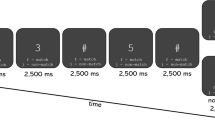Abstract
Deficits in fine motor function and neuropsychological performance have been described as risk factors for schizophrenia. In the Basel FEPSY study (Früherkennung von Psychosen; English: Early Detection of Psychosis) individuals at risk for psychosis were identified in a screening procedure (Riecher–Rössler et al. 2005). As a part of the multilevel assessment, 40 individuals at risk for psychosis and 42 healthy controls matched for age, sex and handedness were investigated with a fine motor function test battery and a neuropsychological test battery. Individuals at risk showed lower performances in all subtests of the fine motor function tests, predominantly in dexterity and velocity (wrist/fingers and arm/hand). In the neuropsychological test battery, individuals at risk performed less well compared to healthy controls regarding sustained attention, working memory and perseveration. The combined evaluation of the two test batteries (neuropsychological and fine motor function) separates the two groups into individuals at risk and healthy controls better than each test battery alone. A multilevel approach might therefore be a valuable contribution to detecting beginning schizophrenia.
Similar content being viewed by others
References
Berres M (2004) Personal communication. Rheinahr Campus Universität Remagen
Bilder RM, Lipschutz–Broch L, Reiter G, Geisler S, Mayerhoff D, Lieberman JA (1991) Neuropsychological deficits in the early course of first episode schizophrenia. Schizophr Res 5:198–199
Box GEP, Cox DR (1964) An analysis of transformations (with discussions). J Royal Statist Soc Series B 26:211–252
Cannon M, Jones P, Huttunen MO, Tanskanen A, Huttunen T, Rabe–Hesketh S, Murray RM (1999) School performance in finnish children and later development of schizophrenia: a population– based longitudinal study. Arch Gen Psychiatry 56:457–463
Chen YL, Chen YH, Mak FL (2000) Soft neurological signs in schizophrenic patients and their nonpsychotic siblings. J Nerv Ment Dis 188:84–89
Cosway R, Byrne M, Clafferty R, et al. (2000) Neuropsychological change in young people at high risk for schizophrenia: results from the first two neuropsychological assessments of the Edinburgh High Risk Study. Psychol Med 30:1111–1121
Drühe–Wienholt CM, Wienholt W (1998) CKV: Computergestütztes Kartensortierverfahren. Swets and Zeitlinger B. V. , Frankfurt am Main
Erlenmeyer–Kimling L, Rock D, Roberts SA, Janal M, Kestenbaum C, Cornblatt B, Adamo UH, Gottesman II (2000) Attention, memory, and motor skills as childhood predictors of schizophrenia– related psychoses: the New York High–Risk Project. Am J Psychiatry 157:1416–1422
Fish B (1987) Infant predictors of the logitudinal course of schizophrenic development. Schizophr Bull 13:395–409
Gediga G, Schöttke H (1994) Turm von Hanoi – TvH. In:Hänsgen K–D (ed) Hogrefe Testsystem (HTS). Hogrefe, Göttingen
Heaton RK (1981) Wisconsin card sorting test manual. Psychological Assessment Resources, Inc. , Odessa, Florida
Hoff AL, Riordan H, O'Donnell DW, De Lisi LE (1991) Cross–sectional and longitudinal neuropsychological test findings in first episode schizophrenic patients. Schizophr Res 5:197–198
Horn W (1984) LPS–3: Leistungsprüfsystem. Hogrefe, Göttingen
Jones P, Rodgers B, Murray R, Marmot M (1994) Child development risk factors for adult schizophrenia in the British 1946 birth cohort. Lancet 344(8934):1398–1402
Jones LA, Cardno AG, Sanders RD, Owen MJ, Wiliams J (2001) Sustained and selective attention as measures of genetic liability to schizophrenia. Schizophr Res 48:263–272
Lehrl S, Merz J, Burkhard, G, Fischer, B (1990) Mehrfachwahl– Wortschatz–Intelligenztest MWT–A, Perimed–Verlag: Erlangen
McNeil TF, Cantor–Graae E (2000) Neuromotor markers of risk for schizophrenia. Aust N Z J Psychiatry 34:S86–S90
Poole JH, Ober BA, Shenaut GK, Vinogradov S (1999) Independent frontal–system deficits in schizophrenia: cognitive, clinical, and adaptive implications. Psychiatry Res 85:161–176
Riecher–Rössler A, Aston J, Borgwardt S, Drewe M, Gschwandtner U, Pflüger M, Stieglitz RD (2005) The Basel early detection of psychosis (FEPSY) project – study design and preliminary results (submitted)
Riley EM, McGovern D, Mockler D, Doku VC, OCeallaigh S, Fannon DG, Tennakoon L, Santamaria M, Soni W, Morris RG, Sharma T (2000) Neuropsychological functioning in firstepisode psychosis – evidence of specific deficits. Schizophr Res 43:47–55
Rosvold HE, Mirsky AF, Sarason I, Bransome ED, Beck LH (1956) A Continuous Performance Test of brain damage. J Consult Psychol 20:343–350
Salthouse TA, Hedden T (2002) Interpreting reaction time measures in between–group comparisons. J Clin Exp Neuropsychol 24:858–872
Schuhfried G (1997) Motorische Leistungsserie (MLS). Hogrefe, Göttingen
Toutenburg H, Haumann C, Nittner T, Scheid S (2002) Parametric and nonparametric regression with missing X'0s – A review. München, Discussion paper 286, SFB 386
Walker EF, Lewine RJ (1990) Prediction of adult–onset schizophrenia from childhood home–movies of the patients. Am J Psychiatry 147:1052–1056
Walker EF, Lewine RR, Neumann C (1996) Childhood behavioral characteristics and adult brain morphology in schizophrenia. Schizophr Res 22:93–101
Wolff AL, O'Driscoll GA (1999) Motor deficits and schizophrenia: the evidence from neuroleptic–naive patients and populations at risk. J Psychiatry Neurosci 24:304–314
Yung AR, Phillips LJ, McGorry PD, McFarlane CA, Francey S, Harrigan S, Patton GC, Jackson HJ (1998) Prediction of psychosis. A step towards indicated prevention of schizophrenia. Br J Psychiatry 33:14–20
Zimmermann P, Fimm B (1993) Testbatterie zur Aufmerksamkeitsprüfung (TAP). Psytest, Freiburg
Author information
Authors and Affiliations
Corresponding author
Rights and permissions
About this article
Cite this article
Gschwandtner, U., Pflüger, M., Aston, J. et al. Fine motor function and neuropsychological deficits in individuals at risk for schizophrenia. Eur Arch Psychiatry Clin Neurosci 256, 201–206 (2006). https://doi.org/10.1007/s00406-005-0626-2
Received:
Accepted:
Published:
Issue Date:
DOI: https://doi.org/10.1007/s00406-005-0626-2




